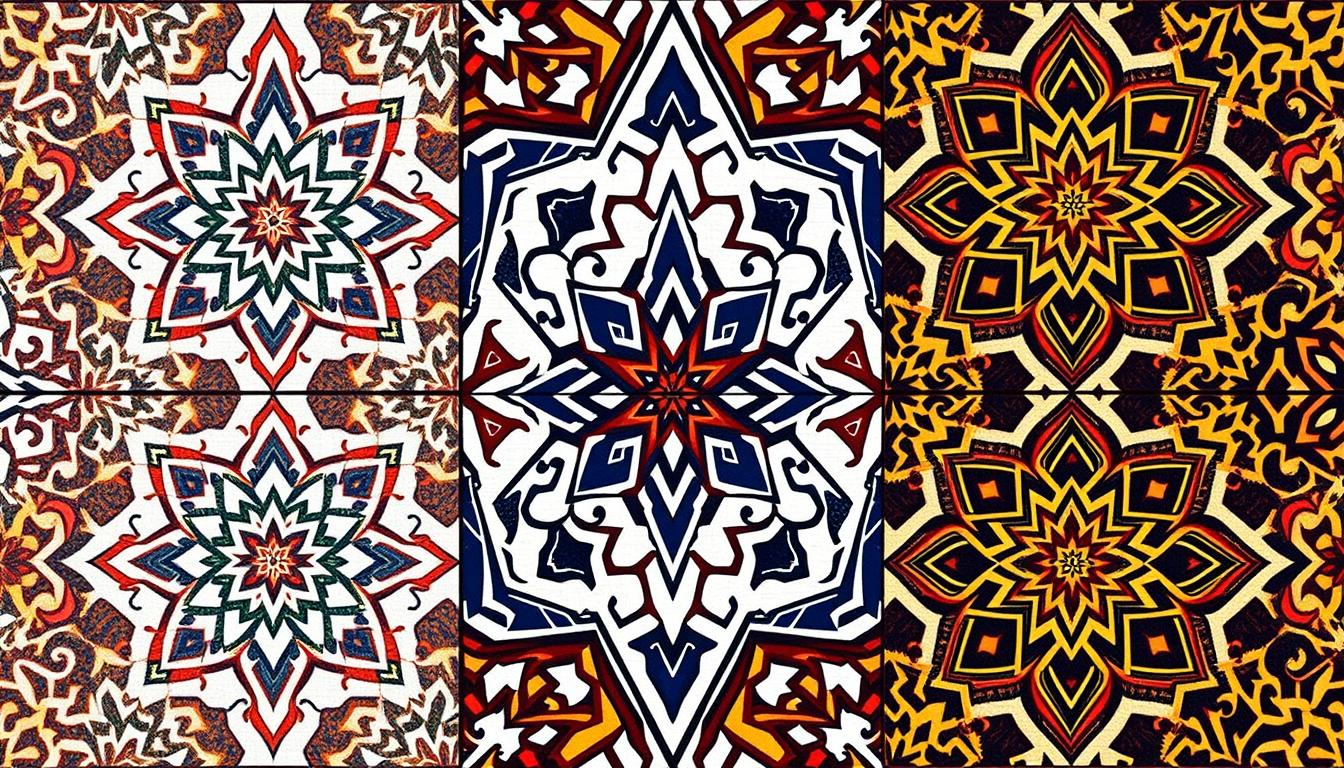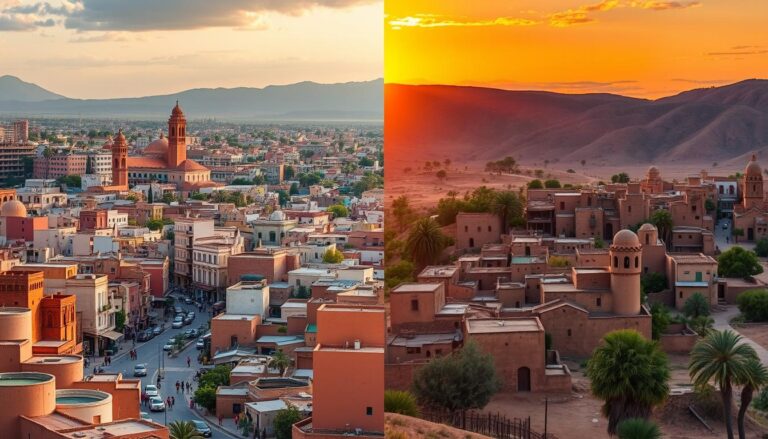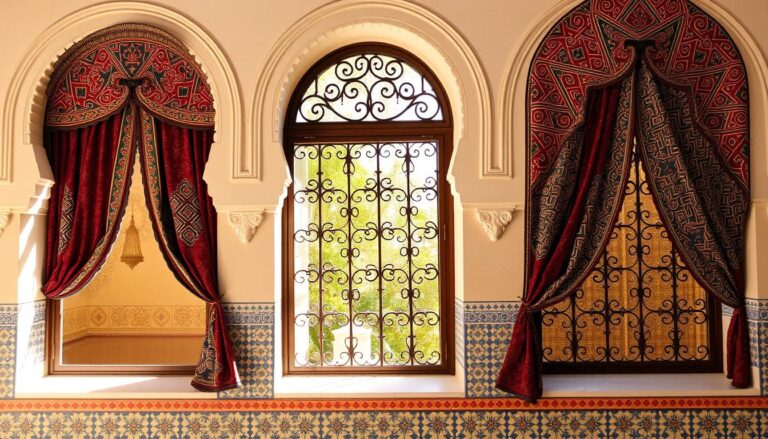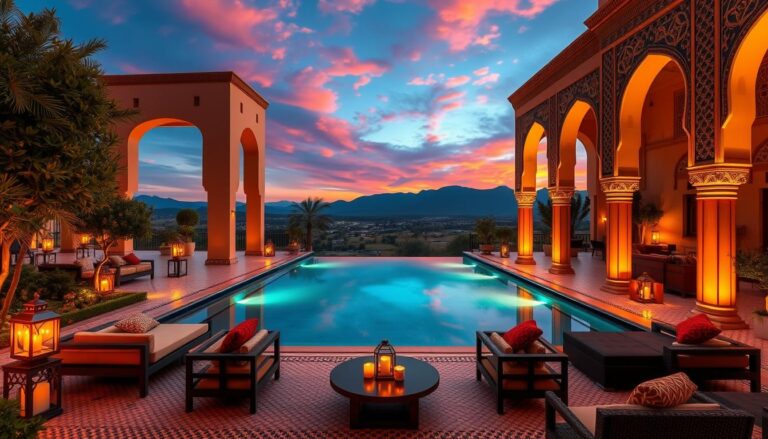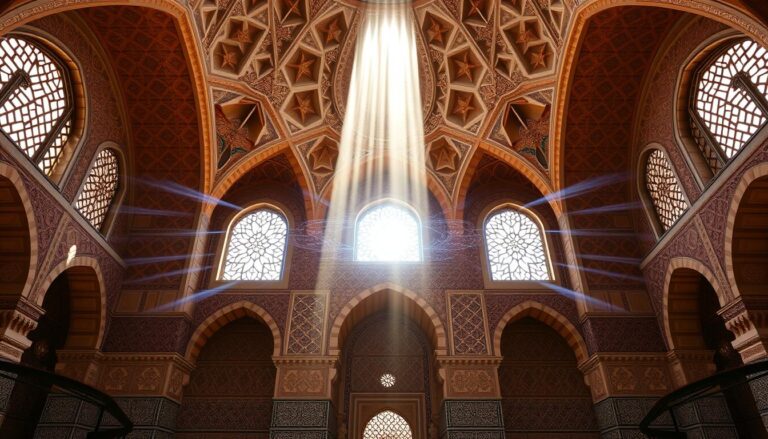Have you ever seen the stunning patterns on Moroccan buildings, mosques, and synagogues? These patterns are a mix of art, math, and culture. They use vibrant tiles and detailed carvings, drawing in artists, designers, and travelers. But what makes these patterns so timeless and captivating?
Key Takeaways
- Moroccan geometric patterns are a unique blend of art, mathematics, and cultural heritage.
- These patterns are found in traditional Moroccan buildings, mosques, and synagogues, showcasing the country’s rich architectural legacy.
- The beauty and complexity of Moroccan geometric patterns stem from the use of simple tools like a compass and straight-edge, along with a deep understanding of geometric principles and tessellation techniques.
- Exploring Moroccan geometric patterns can provide valuable insights into the intricacies of Islamic art and architecture.
- Studying these patterns can be a captivating and meditative experience, offering a glimpse into the intersection of art, mathematics, and cultural traditions.
The Enchanting World of Moroccan Geometric Patterns
Moroccan geometric patterns blend Islamic and Jewish art traditions. They are found in the stunning architecture of the region. These designs, seen on walls, floors, and ceilings of mosques and synagogues, show the country’s rich culture.
Unveiling the Beauty of Islamic and Jewish Art
The geometric patterns in Moroccan design come from Islamic and Jewish art. They use intricate tessellations and bright colors. These patterns reflect the spiritual and symbolic elements of these ancient traditions.
Inspiration from the Traditional Buildings and Mosques
Traditional Moroccan architecture, like grand mosques and zellige-tiled buildings, inspire these patterns. These designs are everywhere in these iconic structures. They show the skill of Moroccan artisans and their knowledge of old techniques.
Over 2 million people worldwide have adopted Moroccan design. Interest in it is growing, with 5 million people now showing interest. The hospitality industry has used these patterns over 8,000 times. Artisan craft exports have also seen a surge, reaching 10 million dollars. This shows the lasting appeal of Moroccan geometric patterns.
“The intricate patterns and vibrant colors of Moroccan design are a true feast for the senses, transporting us to a world of beauty and cultural richness.”
Moroccan Geometric Patterns: A Step-by-Step Journey
Explore the world of Moroccan geometric patterns step by step. Learn the art of using a compass and straight-edge. Discover the secrets of Zellij patterns and the Seal of Solomon.
Mastering the Art of Compass and Straight-Edge Construction
Workshops around the world taught people how to make Moroccan geometric patterns. Craftsman Hamza showed them how to use a compass and straight-edge. They started with the 10-fold rosette, a key Zellij pattern.
They learned the Arabic and English names of each design. They also heard the stories behind them.
From Simple to Sophisticated: Exploring Diverse Patterns
As they went on, they tackled more complex patterns. They saw the 8-fold Seal of Solomon and Islamic designs. Each new pattern showed the beauty and history of this craft.
Hamza taught them about the patterns’ rich history and cultural value. This deepened their respect for zellij patterns.
“The journey of exploring Moroccan geometric patterns is a truly mesmerizing experience, one that connects us to the vibrant history and profound spirituality of this ancient art form.”
By the end, participants loved Moroccan geometric patterns even more. They appreciated their beauty and history.
The Fascinating Principles and Techniques
Making Moroccan geometric patterns involves understanding math and design. Experts like Eric Broug taught these skills in workshops. They learned about pattern analysis and tessellation, using tools like compasses and straight-edges.
Pattern Analysis and Tessellation Fundamentals
Participants learned about the math behind these patterns. They saw how tessellations work. This helped them appreciate the skill needed to create these designs.
The workshops were a chance to explore this ancient art. They showed how math, creativity, and culture come together.
“Geometry is a language that everyone can relate to instinctively,” explains Eric Broug, a renowned practitioner of Islamic pattern design. “The challenge lies in finding innovative ways to push the boundaries of this timeless tradition.”
As they learned more, they were amazed by the sacred geometry in these designs. The workshops stressed the need to know the basics first. This ensures each pattern follows the art’s architectural and mathematical rules.
Unleashing Creativity with Color Palettes
The workshops went beyond just making Moroccan geometric patterns. They explored the power of color. People tried out different color palettes, seeing how colors changed the look and feel of the designs. They used everything from bright, shiny colors to soft, natural tones.
This creative journey led to amazing results. It also helped people connect with the cultural meaning behind these patterns. Moroccan geometric patterns, with their detailed designs and deep history, became a blank canvas for design creativity and artistic expression.
“The color palette was like a magic wand, transforming the geometric patterns into something truly unique and personal. It was a journey of self-discovery, where each stroke of the brush brought us closer to the heart of Moroccan design.”
By using different color palettes, the participants made their Moroccan geometric patterns truly unique. This showed how versatile these patterns are. It also showed how Moroccan geometric patterns can spark creativity.
The workshops showed that Moroccan geometric patterns are more than just technical skills. They are a way to express design creativity and artistic expression. By playing with colors and personal touches, people found the true beauty of this art form. They made it their own and inspired others to see its beauty.
The Meditative and Therapeutic Aspects
Creating Moroccan geometric patterns can make you feel calm and clear-minded. The detailed, repetitive work helps you focus and be mindful. It’s like a meditation, offering a way to relieve stress and find personal joy.
The Calming Influence of Moroccan Geometric Patterns
In Islamic architecture, tile work often shows intricate patterns. These patterns symbolize the endless nature of Allah, making them great for meditation. The tiles, made from clay, ceramics, or glass, add bright colors that make the patterns even more soothing.
These designs are made with care to help with meditation and thinking deeply. They create spaces that are perfect for spiritual practices.
“The act of mindfully drawing and coloring the geometric designs also provided a sense of stress relief and mental well-being, as participants became immersed in the creative process.”
Moroccan zellij tiles show the beauty of mosaic designs in the Islamic world. These patterns not only make places look beautiful but also bring people together. They remind us of our cultural heritage and identity.
Moroccan geometric patterns offer a way to express oneself and find peace. They help people connect with Islamic art and architecture. By exploring these designs, we can find inner calm, relief from stress, and a deeper understanding of ourselves.
Moroccan Geometric Patterns: Bridging Cultures and Generations
The workshops on Moroccan geometric patterns were a special chance for people to learn and bond with their families. They discovered common interests, like a father and daughter’s love for geometry.
A mother and daughter team found a way to grow closer by learning together. They explored the beauty of this art form. This showed how Moroccan geometric patterns can unite people, creating strong cultural exchange and family bonding.
“The workshops on Moroccan geometric patterns provided a unique opportunity for participants to not only learn about this rich cultural tradition but also to forge deeper connections with their loved ones.”
As they learned about Moroccan geometric patterns, families found a common passion. This passion went beyond age and culture. They made lasting memories and strengthened their family bonds.
The workshops focused on art and creativity. This allowed families to explore their shared interests and talents. It fostered intergenerational learning and cultural exchange. This experience enriched their understanding of Moroccan heritage and nurtured the relationships within their families.
Mastering the Art of Moroccan Geometric Patterns
For those drawn to Moroccan geometric patterns, many paths are open. You can learn through online workshops or in-person classes. This journey of hands-on learning can help you master these stunning designs.
Hamza, a skilled craftsman, leads workshops on Moroccan geometric patterns. He teaches the basics of compass and straight-edge use. You’ll also learn about different patterns, gaining a deep understanding of this art.
- The VAWAA Masterclass on Drawing Moroccan Geometric Patterns with Hamza will be held on Saturday, December 19th at 11 AM EST.
- The session will last for 2 hours and is designed at an advanced level, although intermediate participants are welcome.
- Participants will learn to construct a 10-fold pattern from the Attarine Madrasa (14th Century) in Fes Medina, Morocco, called al-Mashar mol ‘Ain al-Shams.
Hamza, an Andalusian Oud musician and geometer, is the founder of a crafts studio in Fes. He brings his deep cultural knowledge and teaching skills to the workshops. His love for Moroccan geometric patterns is contagious, making the learning experience unforgettable.
“The workshop with Hamza was a truly transformative experience. His teaching style and the cultural significance of the art made it an unforgettable journey of creative mastery.”
Whether you’re an experienced artist or just starting, these workshops are for you. They offer a chance to dive into Moroccan geometric patterns. You’ll discover a rich cultural legacy and tap into your creative potential.
Conclusion
Moroccan geometric patterns blend art, math, and culture in a unique way. These designs, seen on traditional buildings and places of worship, fascinate many. By learning how to make these patterns, participants in workshops gained a new respect for this art.
These workshops showed the calming side of creating these patterns. They also highlighted how these designs can bring people together. As more people become interested, learning these patterns online or in person opens up new creative possibilities.
Moroccan geometric patterns are a key part of Islamic art and Moroccan culture. Learning about them can deepen one’s appreciation for Moroccan culture. It also helps individuals discover their own creativity and personal growth.
Source Links
- Patterns in Moroccan Geometry: An Online Exhibition
- Moroccan Geometric Design and Tile-Making
- Luxurious Moroccan Interior Design
- Moroccan Design
- Moroccan Mosaic and Pottery Crafts: A Journey Through Tradition & Art
- Symbolism Of Geometric Patterns In Moroccan Woodworking
- Muslim rule and compass: the magic of Islamic geometric design
- Moroccan Majesty: Exotic Cultural Influences – SofaSpectacular
- Unleashing Creativity: Inspiring Pattern Wallpaper Ideas
- Unleash Your Creativity: Unique Bathroom Wall Tile Ideas
- Top Tile Trends for 2023: Unleashing Creative Design Possibilities
- Tile work – (Art and Meditation) – Vocab, Definition, Explanations | Fiveable
- The Psychedelic Nature of Islamic Art and Architecture
- Unveiling the Mystique of Traditional Mehndi Patterns
- Moroccan architecture
- Moroccan Decorative Arts: Through heritage and craftsmanship
- Masterclass in Drawing Moroccan Geometric Patterns (Advanced)
- Moroccan Geometric Drawing With VAWAA
- Ceramics from Fez: Between Tradition and Modernity » Produits Ceramic
- A Symphony of Art and Geometry – Art Maze

The Editorial Team is a passionate group of Morocco enthusiasts dedicated to sharing the beauty, culture, and wonders of this captivating country. With diverse backgrounds and a deep love for travel, we strive to bring you engaging and informative content that inspires your Moroccan adventures. From uncovering hidden gems and sharing local insights to exploring mouthwatering cuisine and showcasing the vibrant lifestyle, our team is committed to providing you with valuable resources and exciting stories that enhance your exploration of Morocco. Join us on this journey as we celebrate the rich heritage and unforgettable experiences that make Morocco truly special.

